Intelligent Inspection Method for Rebar Installation Quality of Reinforced Concrete Slab Based on Point Cloud Processing and Semantic Segmentation
Abstract
1. Introduction
2. Rebar Segmentation Based on Deep Learning
2.1. Data Acquisition
- In Section 3.1 and Section 3.2, it is used to determine the thickness of the concrete cover, the distance between the upper and lower rebar lattices, and the spacing between double-layer bidirectional rebars through semantic information analysis;
- In Section 3.3, by converting between pixel data and point cloud data, it is possible to ascertain whether each rebar in the mask belongs to the upper or lower layer and to obtain the projection of the rebar axes onto the mask.
2.2. Creation of Rebar Segmentation Dataset RL-600
2.3. Semantic Segmentation Model Training and Testing
2.3.1. Semantic Segmentation Model Introduction
2.3.2. Training Results
3. Inspection of Rebar Installation Deviations
3.1. Concrete Cover Thickness and the Distance Between Upper and Lower Rebar Lattices
- Randomly select three points from the point cloud data for plane fitting to obtain a plane (as shown by the blue plane in Figure 6a);
- Take the points whose distance from the fitting plane is less than the threshold as an “inline set”— is 0.8 times the design value of the concrete cover thickness;
- Iterate step 1 and 2 and stop after times;
- The final chosen result is the bottom formwork plane, (as shown by the green plane in Figure 6a) who has the most inline set, and the plane equation is ;
- Delete the point clouds set belonging to the bottom formwork plane to obtain the point clouds of the upper and lower rebar lattices (Figure 6b).
- Subtract the Z-coordinate value of each point from ; if , it is classified as the lower rebar lattice (as shown by the green point cloud in Figure 7b), otherwise it is classified as the upper rebar lattice (as shown by the blue point cloud in Figure 7b), and the threshold value is generally set to 50 mm;
- Randomly select the Z-coordinates of 1000 points in the lower rebar lattice. Calculate the average value of and subtract 1.2 times the design value of the rebar diameter of the lower layer to obtain the thickness of the concrete cover .
- Randomly select the Z-coordinates of 1000 points in the upper rebar lattice. Calculate the average value of , then obtain the distance between the upper and lower rebar lattice.
3.2. Spacing of Double-Layer Bidirectional Rebar in RC Slab
- Select two points in the current layer of rebar lattice point clouds for fitting the straight line (Figure 8);
- Take the points whose distance from the fitting straight line is less than threshold as an “inline set” (the dark point cloud on the left side of Figure 8). The threshold should be slightly larger than half of the design value of the rebar nominal diameter.Iterate step ①② for times;
- To prevent repeated calculations, delete the rebar point cloud selected in step 3 from the current rebar lattice.
- Repeat steps 1, 2, 3, and 4. When the number of remaining point clouds is less than 0.06 times the total number of point clouds of the current rebar lattice, the extraction of the single rebar point cloud is considered to be completed.
- Randomly select two points as “class centers”, calculate the distances from each point to the two class centers. Then classify each point into the class with a closer distance;
- Recalculate the centroid of the two classes which are the new “class centers”, recalculate the distance from each point to the new “class centers”, and classify it into the class with a closer distance;
- Iterate step 2 and stop after times.
3.3. Rebar Nominal Diameter
4. Verification with Examples and Discussion
4.1. Detection of Concrete Cover Thickness and the Distance Between Upper and Lower Rebar Lattices
4.2. Detection of Spacing of the Double-Layer Bidirectional Rebar
4.3. Detection of Rebar Nominal Diameter
5. Conclusions
Author Contributions
Funding
Data Availability Statement
Conflicts of Interest
References
- O’Connor, M.; Stowe, J.; Potocnik, J.; Giannotti, N.; Murphy, S.; Rainford, L. 3D Virtual Reality Simulation in Radiography Education: The Students’ Experience. Radiography 2021, 27, 208–214. [Google Scholar] [CrossRef] [PubMed]
- Malamateniou, C.; Knapp, K.M.; Pergola, M.; Woznitza, N.; Hardy, M. Artificial Intelligence in Radiography: Where Are We Now and What Does the Future Hold? Radiography 2021, 27, S58–S62. [Google Scholar] [CrossRef] [PubMed]
- Yue, S.; Zhang, Z.; Shi, Y.; Cai, Y. WGS-YOLO: A Real-Time Object Detector Based on YOLO Framework for Autonomous Driving. Comput. Vis. Image Underst. 2024, 249, 104200. [Google Scholar] [CrossRef]
- Huo, R.; Chen, J.; Zhang, Y.; Gao, Q. 3D Skeleton Aware Driver Behavior Recognition Framework for Autonomous Driving System. Neurocomputing 2024, 613, 128743. [Google Scholar] [CrossRef]
- Sabeti, S.; Ardecani, F.B.; Shoghli, O. Augmented Reality Safety Warnings in Roadway Work Zones: Evaluating the Effect of Modality on Worker Reaction Times. Transp. Res. Part C Emerg. Technol. 2024, 169, 104867. [Google Scholar] [CrossRef]
- Arunjaroensuk, S.; Yotpibulwong, T.; Fu, P.-S.; Wang, J.-C.; Hung, C.-C.; Mattheos, N.; Pimkhaokham, A. Implant Position Accuracy Using Dynamic Computer-Assisted Implant Surgery (CAIS) Combined with Augmented Reality: A Randomized Controlled Clinical Trial. J. Dent. Sci. 2024; in press. [Google Scholar] [CrossRef]
- Acke, L.; Corradi, D.; Verlinden, J. Comprehensive Educational Framework on the Application of 3D Technologies for the Restoration of Cultural Heritage Objects. J. Cult. Herit. 2024, 66, 613–627. [Google Scholar] [CrossRef]
- Li, Q.; Yang, G.; Gao, C.; Huang, Y.; Zhang, J.; Huang, D.; Zhao, B.; Chen, X.; Chen, B.M. Single Drone-Based 3D Reconstruction Approach to Improve Public Engagement in Conservation of Heritage Buildings: A Case of Hakka Tulou. J. Build. Eng. 2024, 87, 108954. [Google Scholar] [CrossRef]
- Yuan, X.; Smith, A.; Moreu, F.; Sarlo, R.; Lippitt, C.D.; Hojati, M.; Alampalli, S.; Zhang, S. Automatic Evaluation of Rebar Spacing and Quality Using LiDAR Data: Field Application for Bridge Structural Assessment. Autom. Constr. 2023, 146, 104708. [Google Scholar] [CrossRef]
- Kim, M.-K.; Thedja, J.P.P.; Wang, Q. Automated Dimensional Quality Assessment for Formwork and Rebar of Reinforced Concrete Components Using 3D Point Cloud Data. Autom. Constr. 2020, 112, 103077. [Google Scholar] [CrossRef]
- Chang, C.-C.; Huang, T.-W.; Chen, Y.-H.; Lin, J.J.; Chen, C.-S. Autonomous Dimensional Inspection and Issue Tracking of Rebar Using Semantically Enriched 3D Models. Autom. Constr. 2024, 160, 105303. [Google Scholar] [CrossRef]
- Wang, Q.; Cheng, J.C.P.; Sohn, H. Automated Estimation of Reinforced Precast Concrete Rebar Positions Using Colored Laser Scan Data. Comput.-Aided Civ. Infrastruct. Eng. 2017, 32, 787–802. [Google Scholar] [CrossRef]
- Peng, L.; Chao, W.; Shuangmiao, L.; Baocai, F. Research on Crack Detection Method of Airport Runway Based on Twice-Threshold Segmentation. In Proceedings of the 2015 Fifth International Conference on Instrumentation and Measurement, Computer, Communication and Control (IMCCC), Qinhuangdao, China, 18–20 September 2015; pp. 1716–1720. [Google Scholar]
- Win, M.; Bushroa, A.R.; Hassan, M.A.; Hilman, N.M.; Ide-Ektessabi, A. A Contrast Adjustment Thresholding Method for Surface Defect Detection Based on Mesoscopy. IEEE Trans. Industr. Inform. 2015, 11, 642–649. [Google Scholar] [CrossRef]
- Zhao, H.; Qin, G.; Wang, X. Improvement of Canny Algorithm Based on Pavement Edge Detection. In Proceedings of the 2010 3rd International Congress on Image and Signal Processing, Yantai, China, 16–18 October 2010; pp. 964–967. [Google Scholar]
- Wang, Y.; He, Z.; Zeng, X.; Cen, Z.; Zeng, J.; Ren, X.; Cheng, X. Real-Time Spatial Contextual Network Based on Deep Learning for Bridge Exposed Rebar Segmentation. Constr. Build. Mater. 2024, 449, 138379. [Google Scholar] [CrossRef]
- Mohamed, Y.S.; Shehata, H.M.; Abdellatif, M.; Awad, T.H. Steel Crack Depth Estimation Based on 2D Images Using Artificial Neural Networks. Alex. Eng. J. 2019, 58, 1167–1174. [Google Scholar] [CrossRef]
- Cui, B.; Wang, C.; Li, Y.; Li, H.; Li, C. Application of Computer Vision Techniques to Damage Detection in Underwater Concrete Structures. Alex. Eng. J. 2024, 104, 745–752. [Google Scholar] [CrossRef]
- Loverdos, D.; Sarhosis, V. Pixel-Level Block Classification and Crack Detection from 3D Reconstruction Models of Masonry Structures Using Convolutional Neural Networks. Eng. Struct. 2024, 310, 118113. [Google Scholar] [CrossRef]
- Luo, R.; Zhou, Z.; Chu, X.; Ma, W.; Meng, J. 3D Deformation Monitoring Method for Temporary Structures Based on Multi-Thread LiDAR Point Cloud. Measurement 2022, 200, 111545. [Google Scholar] [CrossRef]
- El-Din Fawzy, H.; Kandeel, R.; Farhan, M. Detection of Deformations in Reinforced Concrete Structures Using Modern Surveying Techniques. Alex. Eng. J. 2023, 70, 191–218. [Google Scholar] [CrossRef]
- Díaz-Vilariño, L.; Conde, B.; Lagüela, S.; Lorenzo, H. Automatic Detection and Segmentation of Columns in As-Built Buildings from Point Clouds. Remote Sens. 2015, 7, 15651–15667. [Google Scholar] [CrossRef]
- Zhao, W.; Jiang, Y.; Liu, Y.; Shu, J. Automated Recognition and Measurement Based on Three-Dimensional Point Clouds to Connect Precast Concrete Components. Autom. Constr. 2022, 133, 104000. [Google Scholar] [CrossRef]
- Yu, J.; Shi, X.; Feng, Y.; Chang, J.; Liu, J.; Xi, H.; Huang, S.; Zhang, W. Machine Learning-Based Design and Optimization of Double Curved Beams for Multi-Stable Honeycomb Structures. Extreme Mech. Lett. 2023, 65, 102109. [Google Scholar] [CrossRef]
- Kardovskyi, Y.; Moon, S. Artificial Intelligence Quality Inspection of Steel Bars Installation by Integrating Mask R-CNN and Stereo Vision. Autom. Constr. 2021, 130, 103850. [Google Scholar] [CrossRef]
- Xin, J.; Akiyama, M.; Frangopol, D.M. Autonomous Detection of Steel Corrosion Spatial Variability in Reinforced Concrete Using X-Ray Technology and Deep Learning-Based Semantic Segmentation. Autom. Constr. 2024, 158, 105252. [Google Scholar] [CrossRef]
- Xi, J.; Gao, L.; Zheng, J.; Wang, D.; Tu, C.; Jiang, J.; Miao, Y.; Zhong, J. Automatic Spacing Inspection of Rebar Spacers on Reinforcement Skeletons Using Vision-Based Deep Learning and Computational Geometry. J. Build. Eng. 2023, 79, 107775. [Google Scholar] [CrossRef]
- Fischler, M.A.; Bolles, R.C. Random Sample Consensus. Commun. ACM 1981, 24, 381–395. [Google Scholar] [CrossRef]
- Ronneberger, O.; Fischer, P.; Brox, T. U-Net: Convolutional Networks for Biomedical Image Segmentation. In Medical Image Computing and Computer-Assisted Intervention–MICCAI 2015; Springer: Cham, Switzerland, 2015; pp. 234–241. [Google Scholar]
- Alharbi, A.H.; Aravinda, C.V.; Lin, M.; Venugopala, P.S.; Reddicherla, P.; Shah, M.A. Segmentation and Classification of White Blood Cells Using the UNet. Contrast Media Mol. Imaging 2022, 2022, 5913905. [Google Scholar] [CrossRef] [PubMed]
- Du, X.-F.; Wang, J.-S.; Sun, W. UNet Retinal Blood Vessel Segmentation Algorithm Based on Improved Pyramid Pooling Method and Attention Mechanism. Phys. Med. Biol. 2021, 66, 175013. [Google Scholar] [CrossRef]
- Liu, F.; Wang, L. UNet-Based Model for Crack Detection Integrating Visual Explanations. Constr. Build. Mater. 2022, 322, 126265. [Google Scholar] [CrossRef]
- Zhang, L.; Shen, J.; Zhu, B. A Research on an Improved Unet-Based Concrete Crack Detection Algorithm. Struct. Health Monit. 2021, 20, 1864–1879. [Google Scholar] [CrossRef]
- Yu, G.; Dong, J.; Wang, Y.; Zhou, X. RUC-Net: A Residual-Unet-Based Convolutional Neural Network for Pixel-Level Pavement Crack Segmentation. Sensors 2022, 23, 53. [Google Scholar] [CrossRef] [PubMed]
- Zhang, W.; Pang, J.; Chen, K.; Loy, C.C. K-Net: Towards Unified Image Segmentation. Adv. Neural Inf. Process. Syst. 2021, 34, 10326–10338. [Google Scholar]
- Chen, L.-C.; Zhu, Y.; Papandreou, G.; Schroff, F.; Adam, H. Encoder-Decoder with Atrous Separable Convolution for Semantic Image Segmentation. In Proceedings of the European Conference on Computer Vision (ECCV), Munich, Germany, 8–14 September 2018. [Google Scholar]
- Hartigan, J.A.; Wong, M.A. Algorithm AS 136: A K-Means Clustering Algorithm. Appl. Stat. 1979, 28, 100. [Google Scholar] [CrossRef]
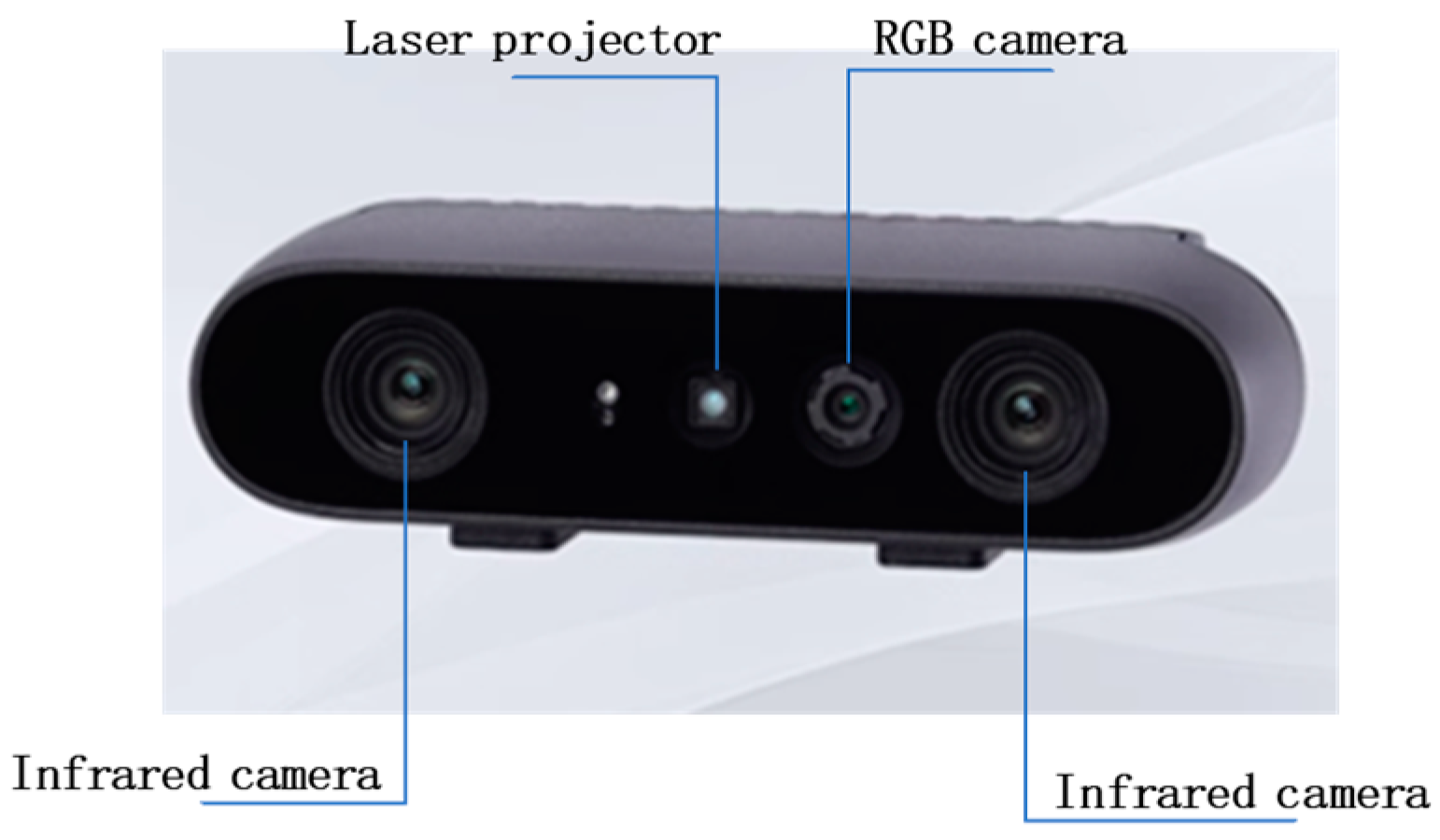
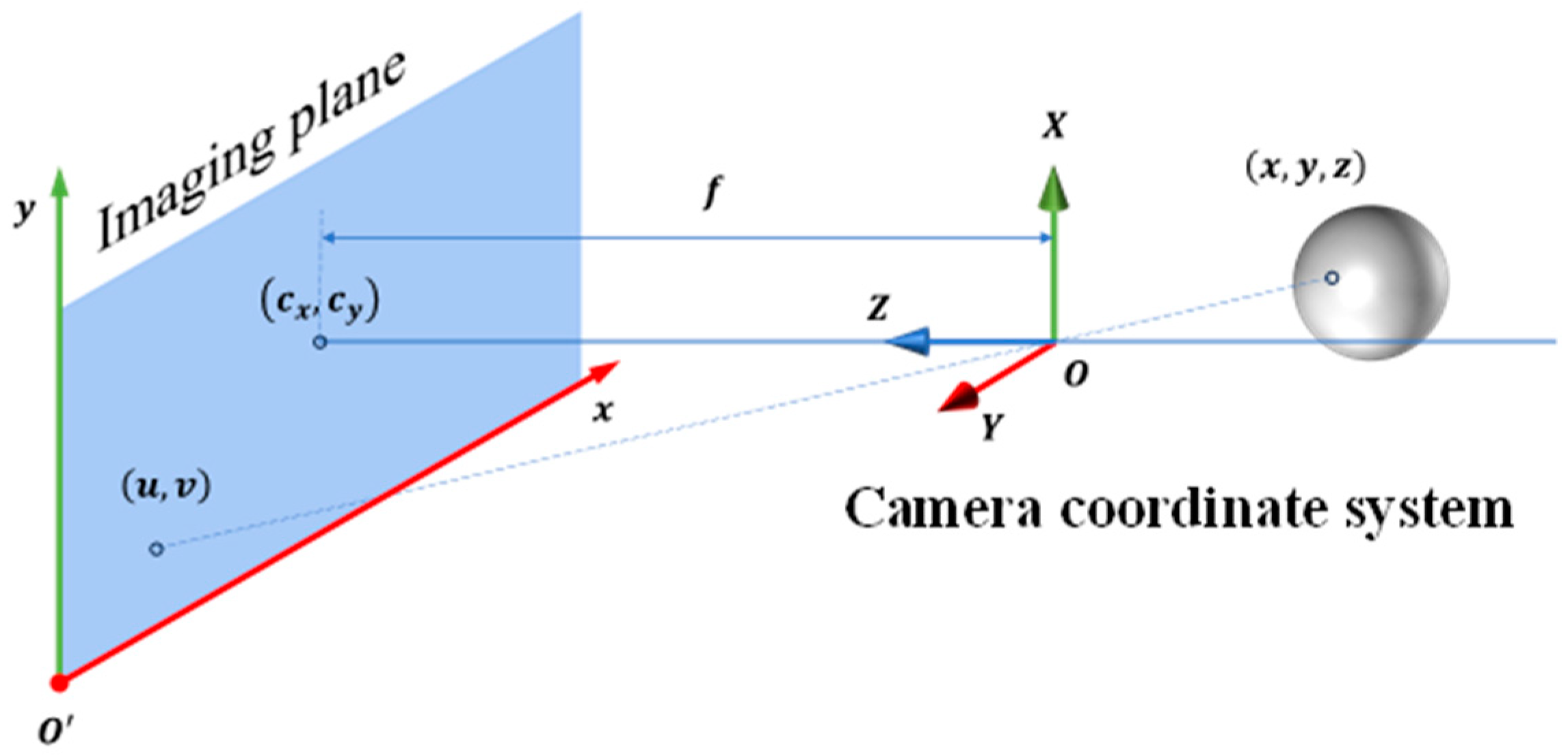
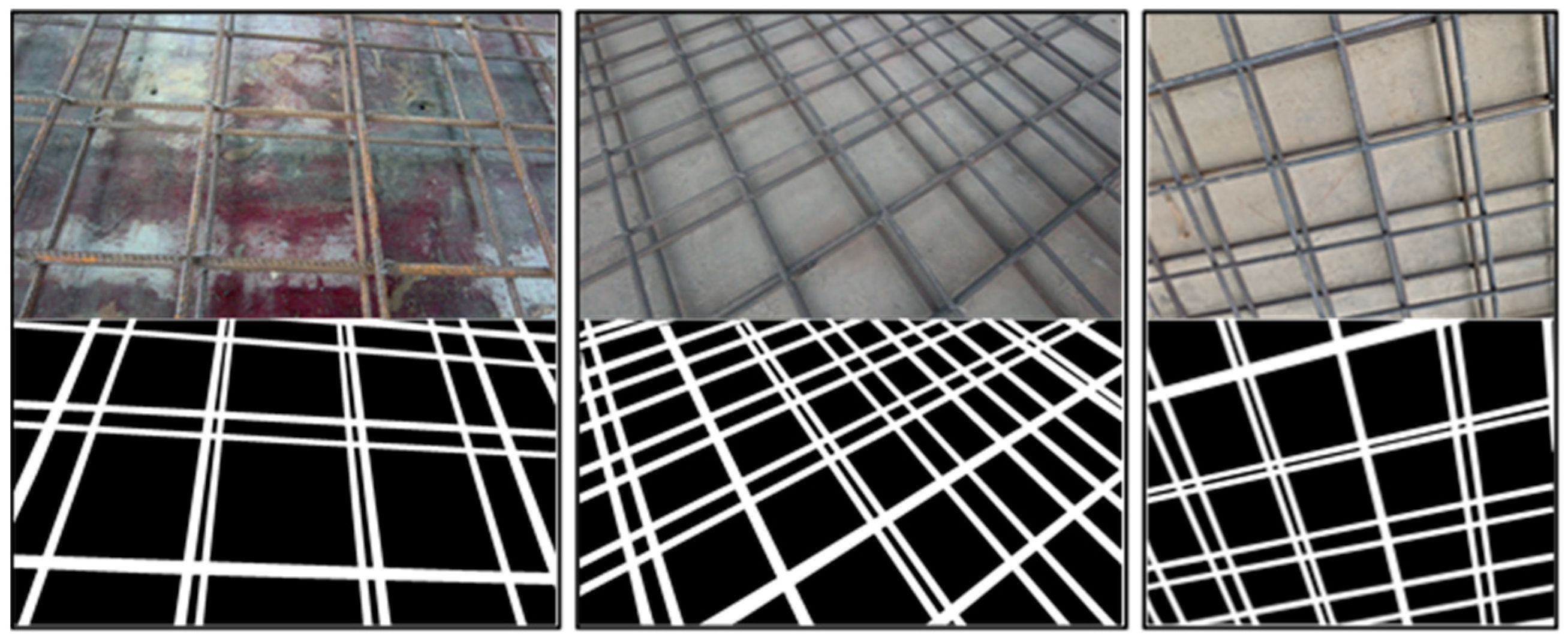



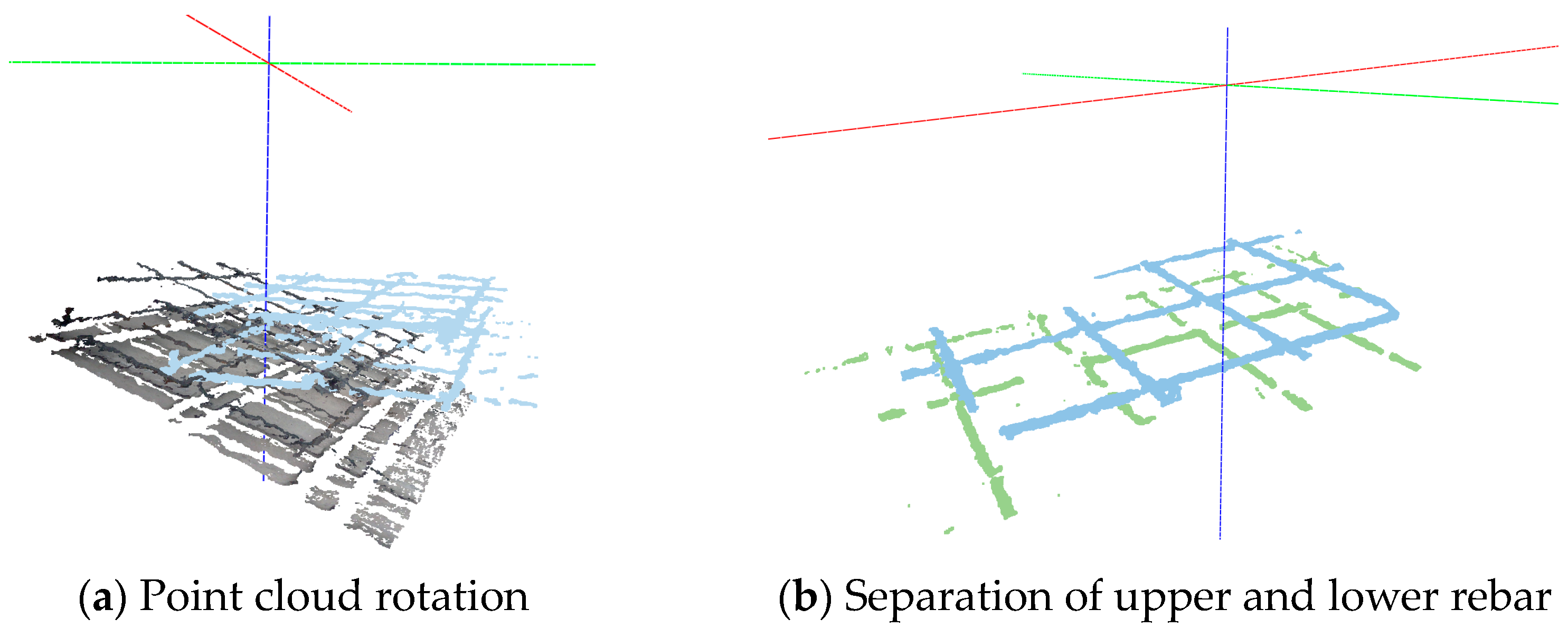


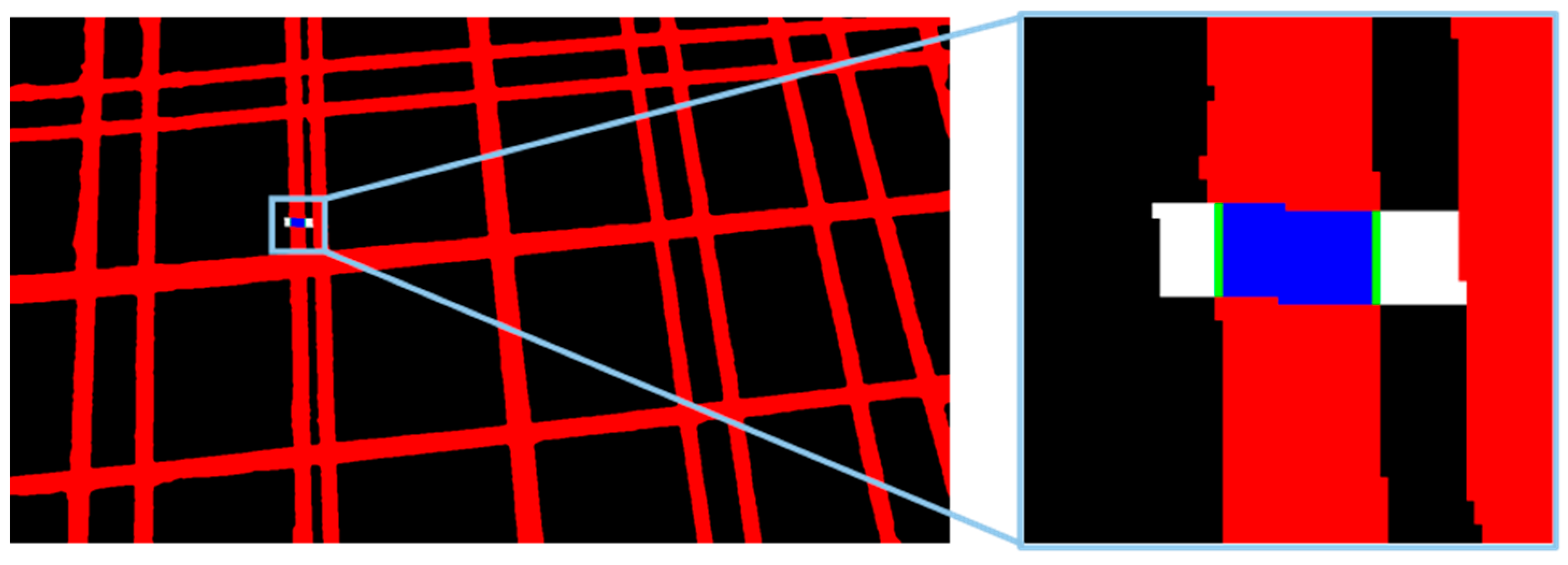



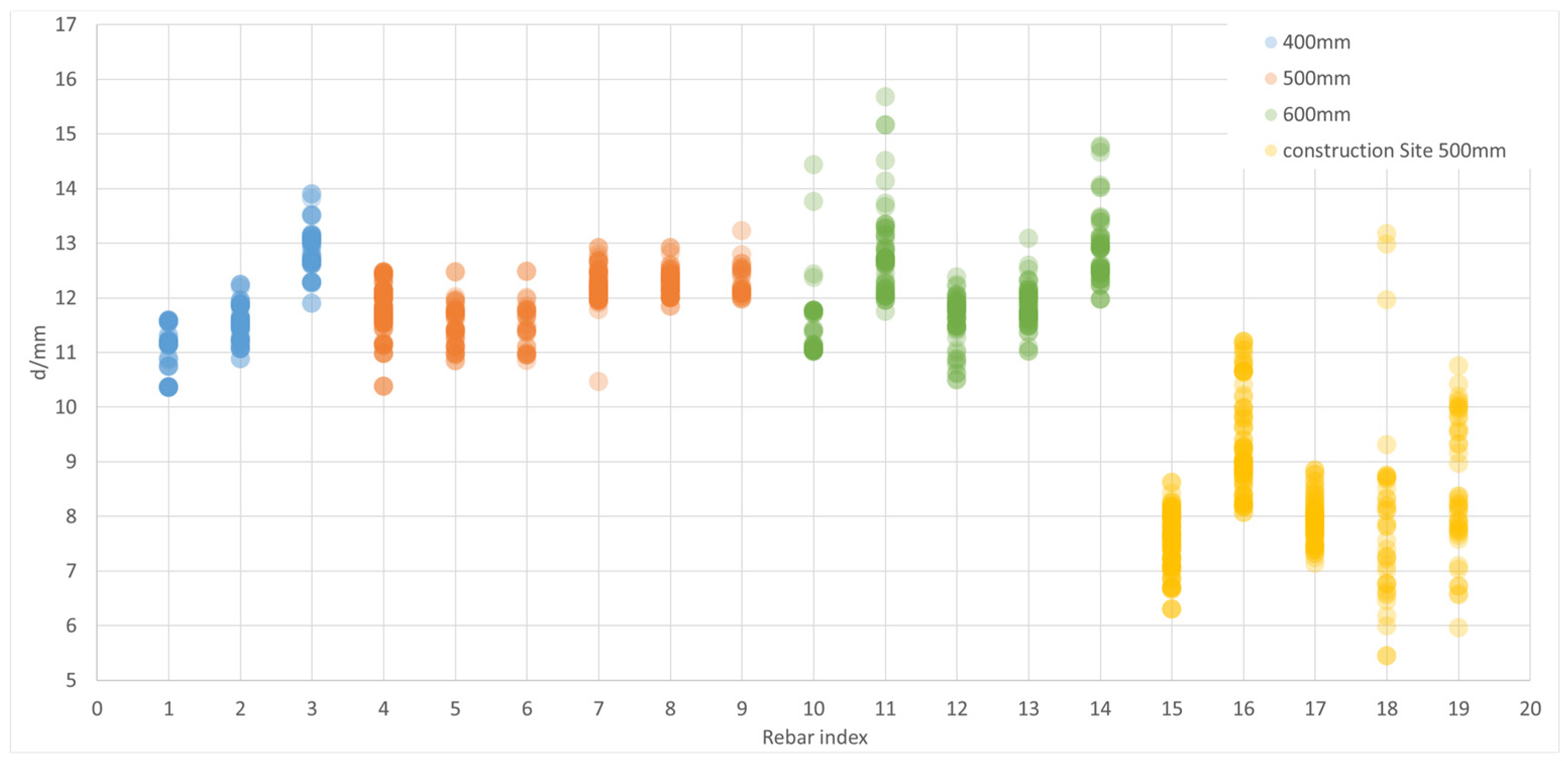

| Images Number | Ratio | |
|---|---|---|
| Train | 410 | 60% |
| Test | 137 | 20% |
| Validation | 137 | 20% |
| Predicted Values | Actual Values | |
|---|---|---|
| Target | Background | |
| Target | TP | FN |
| Background | FP | TN |
| Model | Train | Test | ||||
|---|---|---|---|---|---|---|
| PA/% | IoU/% | Dice/% | PA/% | IoU/% | Dice/% | |
| K-Net | 95.89 | 90.33 | 94.79 | 97.74 | 93.37 | 96.53 |
| U-Net | 92.59 | 83.01 | 90.74 | 95.87 | 88.46 | 93.75 |
| DeepLabV3+ | 95.74 | 88.74 | 94.14 | 97.91 | 92.58 | 95.59 |
| h/mm | Concrete Cover Thickness | Distance Between Upper and Lower Lattices | ||||||
|---|---|---|---|---|---|---|---|---|
| Actual /mm | Detected /mm | Absolute Error/mm | Relative Error | Actual /mm | Detected /mm | Absolute Error/mm | Relative Error | |
| 400 | 15 | 14.59 | 0.41 | 2.7% | 85 | 86.32 | 1.32 | 1.5% |
| 20 | 19.22 | 0.78 | 3.9% | |||||
| 25 | 23.57 | 1.43 | 5.7% | |||||
| 500 | 15 | 14.66 | 0.34 | 2.3% | 85 | 85.37 | 0.37 | 0.4% |
| 20 | 19.31 | 0.69 | 3.5% | |||||
| 25 | 23.82 | 1.18 | 4.7% | |||||
| 15 | 14.46 | 0.54 | 3.6% | 54 | 53.55 | 0.45 | 0.8% | |
| 600 | 15 | 11.24 | 3.76 | 25.1% | 85 | 87.22 | 2.22 | 2.6% |
| 20 | 17.41 | 2.59 | 18.5% | |||||
| 25 | 21.76 | 3.24 | 12.9% | |||||
| h/mm | Rebar Lattice | Actual/mm | Detected (Absolute Error)/mm | Maximum of Relative Error/% |
|---|---|---|---|---|
| 400 | upper | 194, 198 | 191 (−3), 201 (+3) | 1.6 |
| lower | 200, 199, 198, 201 | 198 (−2), 194 (−5), 200 (+2), 205 (+4) | 2.5 | |
| 500 | upper | 205, 194, 194, 198, 205 | 208 (+3), 192 (−2), 191 (−3), 199 (+1), 205 (0) | 1.6 |
| lower | 190, 203, 194, 195, 202 | 191 (+1), 200 (−3), 195 (+1), 191 (−4), 201 (−1) | 2.1 | |
| upper | 149, 150, 148, 148 | 150 (+1), 149 (−1), 152 (+4), 149 (+1) | 2.7 | |
| lower | 151, 153, 148, 149 | 150 (−1), 151 (−2), 150 (+2), 149 (0) | 1.3 | |
| 600 | upper | 188, 210, 205, 200, 205, 186 | 187 (+1), 211 (+1), 204 (−1), 200 (0), 203 (−2), 187 (+1) | 1.0 |
| lower | 199, 195, 202 | 196 (−3), 199 (+4), 202 (0) | 2.0 |
| Point | h/mm | Upper Rebar | Lower Rebar | ||
|---|---|---|---|---|---|
| Total | Wrong | Total | Wrong | ||
| A | 400 | 3 | 0 | 5 | 0 |
| 500 | 6 | 0 | 6 | 1 | |
| 600 | 5 | 0 | 5 | 0 | |
| B | 400 | 4 | 0 | 5 | 0 |
| 500 | 5 | 0 | 5 | 0 | |
| 600 | 6 | 0 | 7 | 0 | |
| C | 400 | 4 | 0 | 5 | 0 |
| 500 | 6 | 0 | 5 | 0 | |
| 600 | 6 | 0 | 6 | 0 | |
| D | 400 | 4 | 0 | 5 | 0 |
| 500 | 6 | 0 | 6 | 0 | |
| 600 | 5 | 0 | 5 | 1 | |
| Site | 500 | 5 | 1 | 5 | 0 |
| Total: | 65 | 1 | 70 | 2 | |
| Accuracy: | 97.8% | ||||
Disclaimer/Publisher’s Note: The statements, opinions and data contained in all publications are solely those of the individual author(s) and contributor(s) and not of MDPI and/or the editor(s). MDPI and/or the editor(s) disclaim responsibility for any injury to people or property resulting from any ideas, methods, instructions or products referred to in the content. |
© 2024 by the authors. Licensee MDPI, Basel, Switzerland. This article is an open access article distributed under the terms and conditions of the Creative Commons Attribution (CC BY) license (https://creativecommons.org/licenses/by/4.0/).
Share and Cite
Wang, R.; Zhang, J.; Qiu, H.; Sun, J. Intelligent Inspection Method for Rebar Installation Quality of Reinforced Concrete Slab Based on Point Cloud Processing and Semantic Segmentation. Buildings 2024, 14, 3693. https://doi.org/10.3390/buildings14113693
Wang R, Zhang J, Qiu H, Sun J. Intelligent Inspection Method for Rebar Installation Quality of Reinforced Concrete Slab Based on Point Cloud Processing and Semantic Segmentation. Buildings. 2024; 14(11):3693. https://doi.org/10.3390/buildings14113693
Chicago/Turabian StyleWang, Ruishi, Jianxiong Zhang, Hongxing Qiu, and Jian Sun. 2024. "Intelligent Inspection Method for Rebar Installation Quality of Reinforced Concrete Slab Based on Point Cloud Processing and Semantic Segmentation" Buildings 14, no. 11: 3693. https://doi.org/10.3390/buildings14113693
APA StyleWang, R., Zhang, J., Qiu, H., & Sun, J. (2024). Intelligent Inspection Method for Rebar Installation Quality of Reinforced Concrete Slab Based on Point Cloud Processing and Semantic Segmentation. Buildings, 14(11), 3693. https://doi.org/10.3390/buildings14113693






